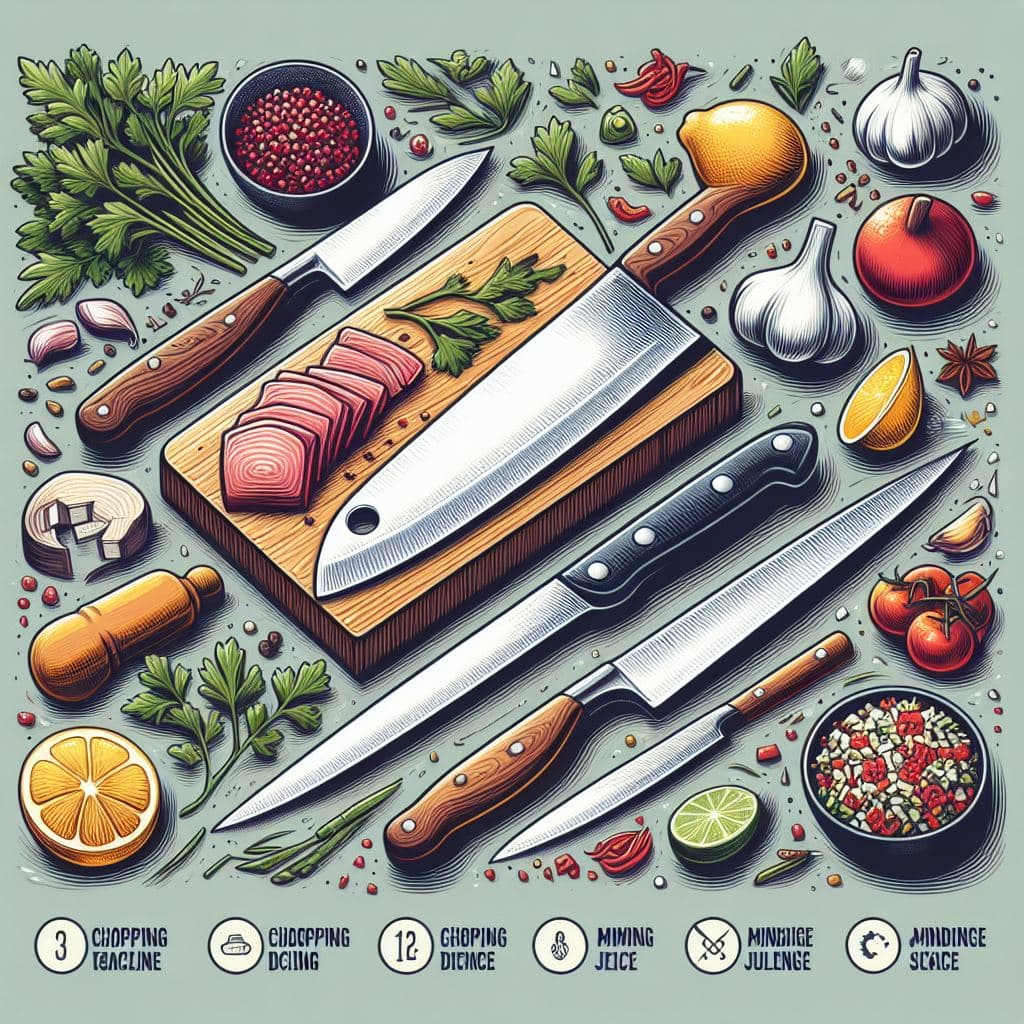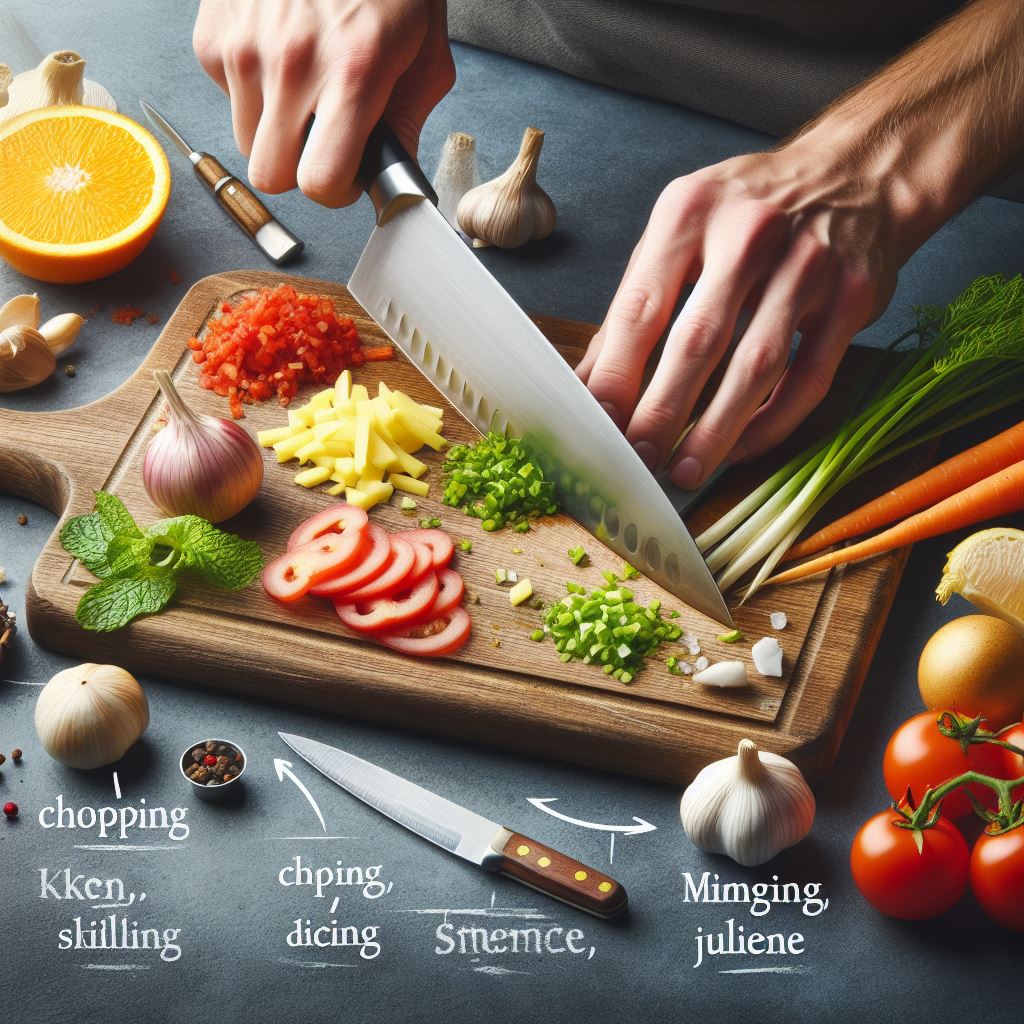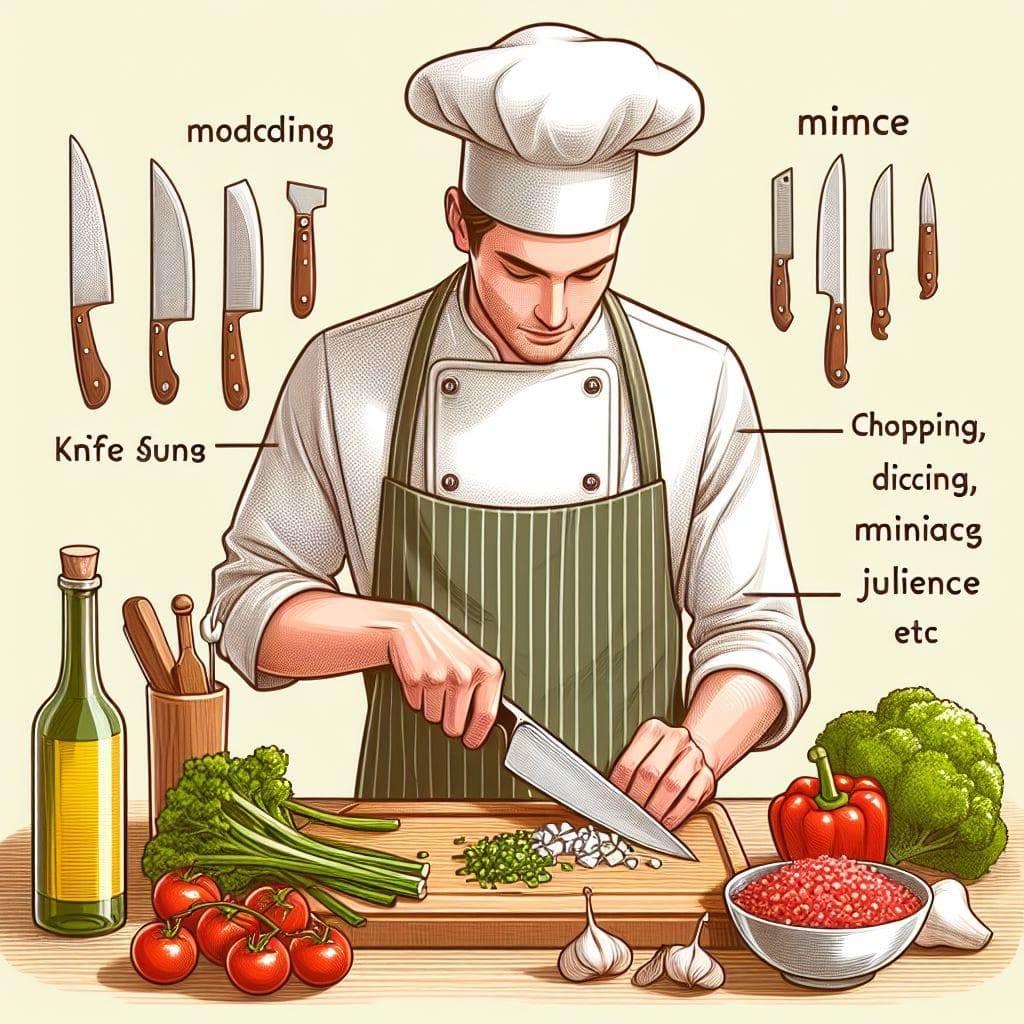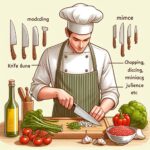Knife skills, such as chopping, dicing, mincing, and julienning, are essential techniques in cooking. They affect a dish’s texture, flavor, and cooking time.
Mastering knife skills is crucial for any aspiring cook or culinary professional, not only for the efficiency and speed they bring to food preparation but also for enhancing the visual appeal and consistency of dishes. Accurate cutting techniques, from the rugged chop to the delicate julienne, lead to more controlled cooking and can significantly influence the outcome of your recipes.
Uniformly cut ingredients cook at the same rate, ensuring each bite is cooked to perfection. Moreover, knowing how to handle a knife with confidence and safety transforms meal prep from a chore into an enjoyable part of the cooking process. Aspiring chefs and home cooks alike benefit from practicing these skills, which serve as the building blocks for a multitude of recipes and culinary endeavors. Incorporating these basic yet important knife skills can dramatically improve the quality and presentation of any meal.

Introduction To Knife Skills
Mastering knife skills is a foundation for any aspiring chef or cooking enthusiast. Knowing how to properly chop, dice, mince, and julienne transforms cooking into an art. Not only does it improve the appearance of dishes, but it also affects the flavor and cooking time. Let’s explore the world of knife techniques and understand why they are so important in the kitchen.
Importance Of Knife Skills In The Culinary Arts
Good knife skills mean efficiency and safety in the kitchen. They lead to consistent food texture and size, which is key for even cooking. A skilled chef also saves time and reduces waste by cutting food properly. Most importantly, proper technique keeps fingers safe from cuts.
Types Of Knives And Their Specific Uses
- Chef’s Knife: Versatile for chopping, slicing, and mincing.
- Paring Knife: Perfect for peeling and trimming small fruits and vegetables.
- Bread Knife: Serrated edge cuts through bread without crushing it.
- Utility Knife: Great for tasks too small for a chef’s knife but too big for a paring knife.
- Boning Knife: Flexible and sharp for removing meat from bones.
Safety First: Handling Knives Responsibly
Safety is paramount when it comes to handling knives. Always keep knives sharp as dull edges are dangerous. Grip the knife correctly with a firm hold for control. Focus on the task to avoid slips and injury. Finally, store knives properly to keep them in good condition and out of harm’s way.
Mastering Basic Cuts
Mastering basic cuts in the kitchen is essential for any aspiring chef or home cook looking to elevate their culinary skills. Knowing how to properly chop, dice, and mince can transform your cooking from good to great. In this guide, we’ll explore some foundational knife techniques. Build your confidence and make meal prep faster and safer with these cutting basics.
The Chop: Techniques And Tips For Coarse And Fine Chopping
Chopping is one of the most common cutting techniques. It comes in two types: coarse and fine. Coarse chopping is less precise and pieces are larger. It’s great for salads and stews. Fine chopping requires more knife control, creating small, even pieces perfect for sautéing.
- Use a sharp knife: A dull knife is dangerous and inefficient.
- Rocker the blade: Keep the tip of your knife on the cutting board and rock the blade up and down.
- Guide with knuckles: Use your non-cutting hand to guide the knife, keeping your fingers tucked away safely.
The Dice: Creating Uniform Cubes For Even Cooking
Dicing involves cutting food into perfect squares. Uniform cubes ensure that every piece cooks at the same rate. Consistent dicing is key for beautiful and delicious dishes.
| Cut Size | Common Uses |
|---|---|
| Large Dice (3/4 inch) | Roasting, Grilling |
| Medium Dice (1/2 inch) | Sautéing, Boiling |
| Small Dice (1/4 inch) | Soups, Sauces |
Start by slicing your vegetable flat on one side to create stability. Cut slices at your desired width, stack them, and slice again into sticks. Finally, cut across the sticks to create cubes.
The Mince: Achieving The Finest Cut For Flavorful Dishes
Mincing is the technique of cutting food into tiny pieces. It’s perfect for herbs and garlic, where the flavor needs to infuse throughout the dish.
- Peel and press: Start by peeling your ingredient, then press it flat with the side of your knife.
- Rock and chop: With a fluid rocking motion, move your knife over the ingredient to cut it into very small pieces.
- Gather and repeat: Use the knife to gather the pieces into a pile and mince again until the desired size is achieved.
Keep your fingers out of the way and let the knife do the work. Speed will come with practice, so focus on technique first.
Advanced Knife Techniques
Welcome to the cutting-edge world of advanced knife techniques. Enhancing your culinary skills requires mastery of various cutting styles that not only improve the dish’s texture and flavor but also contribute to its visual appeal. From elegant vegetable presentations to fine herb preparation, advanced knife skills can elevate your cooking to a professional level. Whether you’re a seasoned chef or a home cook looking to impress, these methods will add precision and artistry to your kitchen repertoire. Let’s dive into some sophisticated slicing and dicing techniques.
Julienne And Batonnet: Cutting For Presentation And Precision
Creating uniform matchstick shapes not only adds visual appeal but also ensures even cooking. Follow these steps to achieve perfect juliennes and batonnets:
- Select a firm vegetable like a carrot or cucumber.
- Trim the ends and create a squared-off base.
- Cut the vegetable into 2-3 inch sections for easy handling.
- Slice sections into thin, flat planks before stacking and cutting into even, slender sticks.
Julienne cuts are typically 1/8 inch thick, while batonnet cuts are a bit larger at 1/4 inch.
Chiffonade: The Art Of Slicing Leafy Vegetables And Herbs
The chiffonade technique involves rolling leafy greens or herbs into a tight bundle and slicing across to create thin ribbons. It’s ideal for basil, mint, or spinach:
- Stack leaves on top of each other.
- Roll them tightly like a cigar.
- Use a sharp knife to make fine, even cuts across the roll.
This method flaunts the delicate structure of greens and herbs in salads and garnishes.

Tourner: Shaping Vegetables Into Seven-sided Footballs
The tourner technique is a true testament to a chef’s dexterity. It results in seven-sided ‘footballs’ from vegetables like carrots, potatoes, and turnips:
- Cut the vegetable into 2-inch lengths.
- Carve an equal-sided football shape using a paring knife, rotating the vegetable after each cut.
- Aim for smooth, continuous curves without flat spots.
Tourner not only looks attractive but also offers consistent shapes for even cooking.
| Technique | Purpose | Ideal for |
|---|---|---|
| Julienne | Presentation/Even Cooking | Carrots, Cucumbers |
| Batonnet | Larger Matchsticks | Zucchini, Potatoes |
| Chiffonade | Thin Ribbons | Basil, Spinach |
| Tourner | Consistent Shapes | Carrots, Turnips |
Practice And Maintenance
Mastering knife skills is critical for any aspiring chef or home cook. Just like any craft, these skills demand dedication in both practice and upkeep. Professional chefs spend hours honing their techniques to chop, dice, mince, and julienne with precision. A well-maintained knife is a chef’s best friend, making these tasks easier and safer. In this section, we delve into how consistent practice and proper maintenance form the backbone of impeccable knife skills.
Improving Speed And Consistency Through Practice
- Start with basic cuts: Master simple cutting styles before moving on to more complex techniques.
- Use the right knife for the job to improve control and efficiency.
- Establish a rhythm: Find a comfortable pace to maintain speed without sacrificing safety.
- Repeat often: Dedicate time each day to practice for muscle memory development.
Sharpening Your Skills: Knife Sharpening Techniques
Sharp knives lead to better results and decreased risk of accidents. Use the right sharpening tools and techniques to keep your blades in top condition:
- Honing rods realign the edge and should be used regularly.
- Whetstones can sharpen dull blades when used with the proper technique.
- Professional sharpening is recommended periodically for optimal performance.
Long-term Care: The Dos And Don’ts Of Knife Maintenance
| Do’s | Don’ts |
|---|---|
| Clean knives by hand after each use. | Don’t put knives in the dishwasher. |
| Store knives in a block or on a magnetic strip. | Don’t toss knives into a drawer. |
| Dry knives immediately to prevent rust. | Don’t leave knives wet or soiled. |
| Inspect knives regularly for damage. | Don’t ignore small chips or bends. |
Applying Knife Skills In Cooking
Kitchen success often starts with a chop, dice, or slice. Knife skills are essential for every cook. Mastering these skills makes home cooking quicker, safer, and more fun. Let’s dig into how different knife techniques can elevate your cooking.
Recipes That Showcase Different Knife Techniques
- Chopped Salad: Practice your chopping with a vibrant, colorful salad.
- Ratatouille: Fine dicing shines in this classic French vegetable dish.
- Salsa: Mincing garlic and onions skillfully means perfect salsa every time.
- Stir-Fry: Quick-cooking needs precise julienne cuts for even textures.
Timing And Order: When To Cut During The Cooking Process
Preparation is key in cooking. Start with ingredients that take longer to cook.
Cut these first:
- Root vegetables for a hearty stew
- Onions for caramelization
Save these for last:
- Herbs for garnishing
- Greens that wilt quickly
From Professional Chefs To Home Cooks: Integrating Skills Into Everyday Cooking
Adopting chef-level knife skills isn’t just for show. It’s about efficiency and safety. Try these tips:
- Maintain Sharp Knives: A sharp knife is a safe knife. It gives cleaner cuts.
- Use the Right Knife: Match the knife to the task for best results.
- Practice Consistency: Uniform cuts mean even cooking.

Conclusion
Mastering various knife techniques enhances your culinary expertise and kitchen safety. Streamline your food prep with these skills, from chopping to julienne. Keep practicing, and soon, precision and speed will be your kitchen allies. As you continue to slice and dice, embrace the journey to becoming a more proficient and confident chef.
Frequently Asked Questions For Knife Skills: Chopping, Dicing, Mincing, Julienne, Etc.
What Are The 5 Basic Knife Skills?
The five basic knife skills include chopping, slicing, dicing, mincing, and julienning. Master these techniques for improved kitchen efficiency and safety.
What Are The 4 Knife Techniques?
The four knife techniques include chopping, slicing, dicing, and mincing. Each technique has its specific purpose and method for enhancing food preparation precision and efficiency.
What Are The 4 Basic Types Of Cuts?
The four basic types of cuts are the julienne cut, dice cut, chop, and mince. Each technique varies in cut size and is used for different culinary purposes.
Is Mincing A Knife Skill?
Yes, mincing is a fundamental knife skill that involves cutting food into very small pieces, often for flavor dispersion in dishes.







